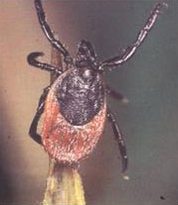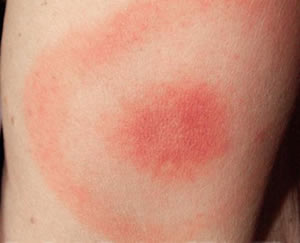
Tick bite
What is a tick bite?
Tick bite infections
Symptoms of tick bite
Tick bite prevention
Tick removal from the skin
Remedies / cures / treatment for tick bite
References
What is a tick bite?
Ticks are small eight legged insects that feed on the blood of mammals and birds. Ticks find their hosts by sensing animals' breath and body odours, heat, moisture and vibrations. Ticks are not able to fly or jump, so they have to wait for a host to brush past. They hold onto leaves and grass with their third and fourth pair of legs, leaving their first pair of legs outstretched, waiting to climb on to a host. Some ticks will attach quickly while others will wander around the body looking for thinner skin (like behind the ear). Depending on the species and the life stage, attachment for preparing to feed can take from ten minutes to two hours. On locating a suitable feeding spot, the tick grasps the skin and cuts into the surface.

Tick bite infections
Tick bites can sometimes be more serious than mosquito or flea bites, because of the potential of ticks to carry a variety of infections. However most ticks do not carry diseases and a tick bite is not normally a serious problem. Possible tick infections vary depending what part of the world you are in, and are most prevalent in the warm to temperate latitudes of the world. Ticks can carry more than one type of infection, so those bitten can be infected with more than one pathogen at the same time, making diagnosis and treatment difficult. The tick itself can also contain toxins.
Bacteria: rickettsia, borrelia (Lyme disease), ehrlichia, anaplasma phagocytophilum, francisella tularensis, babesia and other types of bacteria.
Viruses: Tick-borne meningoencephalitis, Colorado tick fever, Crimean-Congo hemorrhagic fever, and febrile Illness caused by the Heartland virus.
Protozoa: Babesia microti, B. equi, Cytauxzoonosis felis.
Symptoms of tick bite
Symptoms vary depending on the type of infection(s) that the tick is carrying, but commonly include:

- A swollen, red, inflamed area on the skin. Sometimes a rash can form as a ring or circle around the bite. On rare occasions, there is a beadlike lump.
- Body aches, joint pains.
- Fever.
- Fatigue.
- Mammalian meat allergy (MMA). Caused by improper Tick removal from the skin after a tick bite. If you squeeze the tick as you remove it, you inject its stomach contents into your blood. If the tick has recently fed on the blood of a non-primate mammal (cows, sheep, pigs, goats, kangaroo, antelope, or many other mammals) it will probably have the sugar Alpha GAL in its stomach. Alpha GAL is a sugar in the blood of most mammals except primates. Even though Alpha GAL is a carbohydrate, when it gets into the human bloodstream it is marked by the immune system as an invader. After such a tick bite, if that person eats red meat, their body has an allergic reaction. In many cases, it can be an anaphylactic allergic reaction and they can never eat red meat again.
Tick bite prevention
Ticks tend to be more active during warmer months, though this varies in different climates and parts of the world. Areas with woods, bushes, high grass, or leaf litter are likely to have more ticks. Population density goes up with the number of deer, small mammals and birds upon which they can feed. Tick population increases with the presence of domestic animals and livestock. An exception is the Guineafowl, which loves to eat ticks and can reduce tick population in a high tick prevalence area.
Limit your exposure by wearing light-coloured clothing (which makes the ticks easier to see), fully covering your legs and arms, tucking pant legs into socks, and checking for ticks frequently. At the end of the day in a risky area, wash your clothes and dry them in a hot dryer.
Tick removal from the skin
If you see a tick on the skin, try to remove it as quickly and carefully as possible. Ensure you remove the head and do not leave it lodged in the skin. After removal wash the area with soap and water, and then apply a disinfectant. The best disinfectant is a drop of iodine directly on the bite, leaving the wet drop undisturbed for a couple of minutes.
The risk of infection increases with the time a tick is attached to your body, so attached ticks should be removed as quickly as possible. If a tick is attached for less than 24 hours infection is unlikely. Removal within 36 hours reduces transmission rates. (1) However, some ticks are very small, especially in the nymph stage, so prompt detection is difficult.
The best method to pull a tick out is with small pointed tweezers as close to your skin as possible. Insert the pointed tweezers between the tick's body and your skin. Gently and directly pull the tick straight out with steady pressure. Do not twist as you pull, as this increases the chance of leaving the head embedded in your skin. Do not squeeze the tick by holding its swollen body as this may squeeze infected fluid from the tick back into your skin. This will substantially increase the risk of infection, and may cause Mammalian meat allergy. (2) So do not use your fingers or standard tweezers to pull out the tick.
If you don't have any fine pointed tweezers, an alternative removal method is to use a thread such as a piece of cotton or dental floss. Make a loose half-hitch knot and slip it over the tick as close as possible to your skin. Pull it taut and then gently pull the tick out.
Perhaps the safest method to remove ticks is with a can of freeze-off wart remover, available from chemists. Follow the instructions and spray the remover on the tick, freezing it solid and killing it. When the tick is frozen solid you can easily pull it off with your fingers, and there is no danger that you will squeeze its stomach contents back into your skin.
It is NOT true that petroleum jelly, nail polish, gasoline, a hot match or rubbing alcohol help to remove a tick attached to your skin. These practices may make it burrow more deeply or release fluid back into your body and increase your risk of infection.
If the tick's head and mouthparts are missing from its body after removal, then they are probably still embedded in your skin, and may be visible. Douse the bite twice a day with a drop of iodine, or if that is unavailable, a strong antiseptic. This will reduce the risk of infection from the embedded parts until they detach on their own, which may take hours to days. Sometimes a punch biopsy may be necessary to remove embedded tick parts.
Remedies / cures / treatment for tick bite
- Iodine. In this case you can use any type of iodine: Nascent, Povidone or Lugol's.
- See details of remedies recommended by Grow Youthful visitors, and their experience with them.
References
1. Piesman J, Dolan MC.
Protection against lyme disease spirochete transmission provided by prompt removal of nymphal Ixodes scapularis (Acari: Ixodidae).
(May 2002). J. Med. Entomol. 39 (3): 509-12. doi:10.1603/0022-2585-39.3.509. PMID 12061448.
2. Zeller JL, Burke AE, Glass RM.
JAMA patient page: Lyme disease.
(June 2007). JAMA 297 (23): 2664. doi:10.1001/jama.297.23.2664. PMID 17579234.
